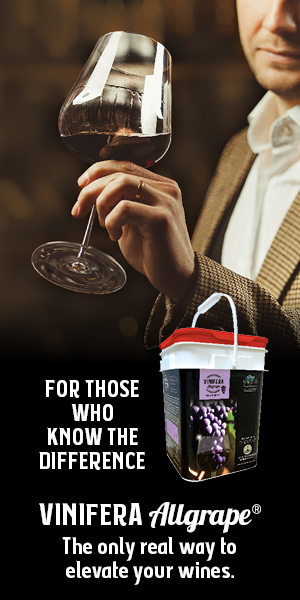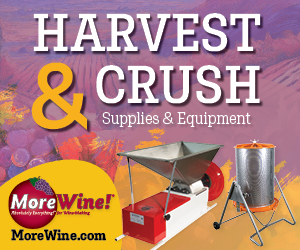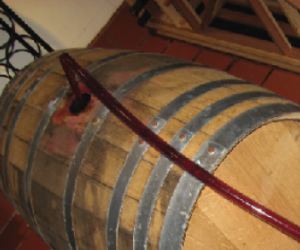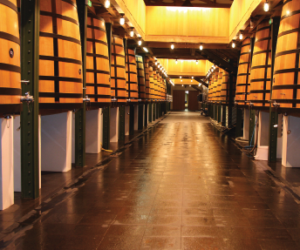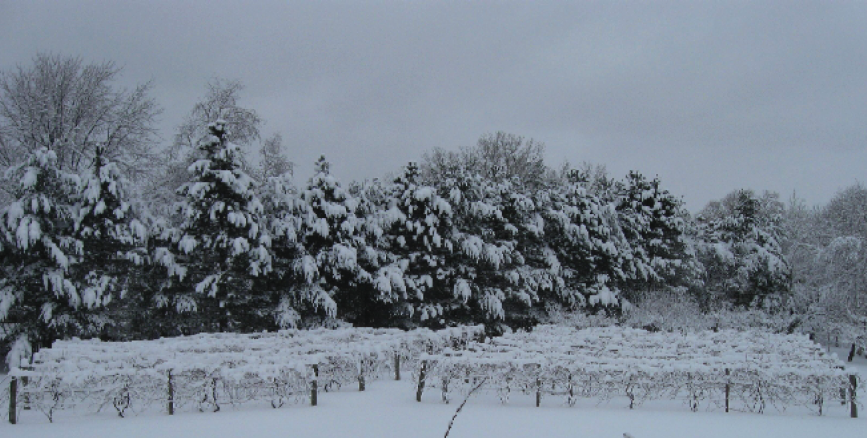
In this article I will discuss the degrees of cold temperature damage that can occur in grapevines, techniques to assess that damage, and ways to increase the likelihood that your remaining live vines will have the best possible outcome during the growing season. I will also discuss some preventive measures that can be used to minimize vine damage from cold weather.
Pockets of Damage
Cold temperatures can hit some areas of your vineyard hard while other nearby areas can be left unscathed The patterns of cold temperature or frost damage in a geographic area, in a vineyard, or even on a single grapevine can seem illogical. Why does one vineyard experience severe damage while a nearby vineyard does not? Why does one vine freeze to death, while the adjacent vine does not?
Location is the first significant variable. The USDA Plant Hardiness categories can be used to determine which vines will most likely thrive where your vineyard is located, and which vines will not. You can use your Zip Code to determine your Plant Hardiness Zone at the following web site: http://planthardi
ness.ars.usda.gov/PHZMWeb/.
Once you know your Plant Hardiness Zone, you can use the Vine Characteristic Chart provided each season by Double A Vineyards on their website at https://www.doubleavineyards.com/Images/Grapevine%20Characteristic%20Chart.pdf. The Vine Characteristic Chart will show which vines will grow in which Plant Hardiness Zones. Generally speaking, vinifera vines are usually hit the hardest by cold temperatures, hybrid vines less so, and native cultivars encounter the least cold temperature damage.
Within a Plant Hardiness Zone, there are other location and topology variables that can affect winter damage of grapevines. Vineyards located near a deep body of water that doesn’t freeze may enjoy a microclimate that enables more cold sensitive cultivars to be grown because extreme temperature swings are mitigated. The first and last frost dates can also be different near a deep-water lake. For example, researchers at Cornell University have done an empirical study to chart the locations of vinifera and hybrid vineyards near Keuka Lake, which is one of the deep New York Finger Lakes. The study showed that vinifera cultivars were primarily planted within a distance of one mile from the shore of the lake, and beyond that first mile, primarily hybrid cultivars were grown. Elevation, slope, and aspect (the compass direction that a slope faces) can also have an effect on the propensity towards cold temperature damage in grapevines.
Vine Health Going Into the Winter
The health of a vine can also determine if the vine will encounter cold damage. The carbohydrates that are produced by photosynthesis are stored in the woody parts of the vine and the root system. These carbohydrates provide the energy needed by the vine to begin its rapid growth in the spring, as there isn’t any photosynthesis taking place in the spring because there aren’t any leaves yet. A vine that hasn’t been healthy during the growing season sometimes won’t produce the normal amount of carbohydrates. In such a case, the vine will be weak. There is a condition known as vine collapse in which a vine will start out growing nicely, and may even bear grape clusters, but then the vine will suddenly collapse. The vine may collapse entirely and die, or it may only partially collapse. A partial collapse could result in only one trunk or cordon dying.
Vine collapse can also occur if a trunk, cordon, or cane has been severely damaged by freezing temperatures. Vascular tissues that conduct nutrients and water are on the outward areas of the trunks, cordons, and lignified canes, near the bark. At a certain sustained freezing temperature, the vines vascular system will encounter cell damage and render it nonfunctional or severely impaired.
Similar to the cells in the vine’s vascular system, the cells in a node (dormant buds) will also encounter lethal damage at certain low temperatures. The plant hardiness of a vine varies by cultivar which means that the lethal temperature in which cell damage occurs is different in different cultivars. You can see this differentiation by looking at a vine characteristic chart, which provides the cold hardiness zones a particular cultivar is suited for. As previously mentioned, you can use the Double A Vineyards Vine Characteristic Chart.
Degrees of Damage
Vines are quite resilient, and a less serious injury occurs when the trunks have all died but roots underground are alive and well because they were somewhat protected from the cold because of the soil. In the case of the root system being intact, the vine will typically push up a number of sucker shoots from the base of the vine, in an attempt to re-establish itself. These suckers, if healthy, can be trained to re-establish the trained vine that was lost.
Partial trunk, cordon, and cane damage can also occur as a result of cell damage in the vascular system as mentioned earlier. In cold damage prone areas, growers will typically train multiple trunks. Growers may also retain multiple spurs in the head area of the vine to allow multiple chances of selecting a healthy cane when pruning in the spring. Practices such as these are sometimes referred to as “Spare Parts Viticulture.”
Bud damage is the most common cold temperature injury that a vine experiences. Bud damage can occur to varying degrees. Usually some of the buds are damaged, but not all. Some dead nodes along a cane will leave gaps, which will reduce the number of buds per linear foot of trellis unless some compensating measures are taken. In the event of only partial bud damage, the yield may be salvaged by retaining more buds than usual, which we will discuss next.
Assessing Bud Damage
Every node on a cane contains a compound bud. There are three buds in a compound node and they are called the primary, secondary, and tertiary buds. The primary bud will produce a shoot that will be most fruitful, usually producing two clusters per shoot. If a primary bud is damaged, by frost, freezing temperatures, or even from insects such as the Grape Flea Beetle, the secondary bud will produce a shoot. The secondary bud may produce a shoot even in the event that the primary bud is also producing a shoot. In this instance, both a primary bud shoot and a secondary bud shoot will form from the same node. The secondary shoot is usually less fruitful, and will typically bear only one cluster of grapes. The tertiary bud is a third chance that Mother Nature gives the grapevine. In the event that the primary and the secondary buds are damaged, the tertiary bud will produce a shoot. The shoot from the tertiary bud is usually not fruitful, but it will produce a large amount of leaves that will keep the vine alive and through photosynthesis, it will produce the carbohydrates necessary for the vine to grow again the following spring.
We can assess bud damage by using a razor blade to cut the bud diagonally, in such a manner so we can see all three buds in the node, and looking to see which ones are alive or dead. Usually the grower will cut several canes in each block of the vineyard, and especially taking a representative sample from each cultivar in the vineyard. Cane sections are cut from areas of the vine that would not typically be retained when pruning is performed in the spring. Each cane section used for sampling bud damage should have several nodes, approximately ten. The sample canes are brought indoors where individual bud analysis will take place.
The healthy buds will appear green when looking at the cross section and the dead buds will appear dark brown or black. When assessing bud damage, if the primary bud is dead, the entire bud is not counted. When all the buds have been cut and analyzed for a particular cultivar in the vineyard, or a particular block of the vineyard, they are tallied up. The calculation is made to determine the percentage of dead buds encountered.
Once we know the percentage of the buds that are damaged, the extra number of buds that should be retained can be calculated. Let’s assume that the normal goal is to retain six buds per linear foot of trellis when there isn’t any bud damage. In years when we experience a percentage of dead buds due to freezing temperatures, we will increase the number of buds retained per linear foot of trellis. For example, if our razor blade bud assessment has shown that we are experiencing 33% bud loss, we should retain 33% more buds per linear foot of trellis to make up for the loss. So when we prune in the spring, instead of retaining six buds per linear foot of trellis, we will retain eight buds per linear foot of trellis. (6 + 33% = 8) Quite often, growers will retain more than the calculated number of extra buds, and then remove any excess buds once the buds begin to swell or begin to burst. That way the number of buds retained can be managed more closely to the actual target of six buds per linear foot of trellis.
Videos created by the Cornell Finger Lakes Grape Program that show how to assess bud damage can be found on YouTube by searching for “FLGP Bud Injury Testing” or browsing the videos posted at their YouTube channel at www.youtube.com/user/cceflgp.
Replant or Recover?
For commercial vineyards, the decision to replace cold damaged vines vs. retraining the sucker shoots from the ground is an economic one. There are government programs that may provide financial assistance to growers who have experienced total or partial vine loss. The financial assistance is based on the amount of damage and the degree of damage. A threshold of damage must be met before assistance will be provided. Another protection that commercial growers can opt for is crop insurance. These options are not available to hobby growers, but a similar “replant or recover” decision may have to be made by the hobbyist.
If the vine is completely dead, the decision is easy. It must be replaced. If a vine has experienced total trunk loss, the vine may be recovered by training sucker shoots back onto the trellis. If the sucker shoots are plentiful and healthy, retraining is usually a preferred option, because an intact mature root system will restore the vine into production in less time than a newly (re)planted vine. If the sucker shoots are very small and weak, they may indicate more severe damage to the entire vine including the root system. In the case of small, weak sucker shoots, the vine should probably be replaced instead of taking a chance that the vine will recover fully. At least if we replant, we can expect that we will have a productive vine in three years. If we wait a year to see if a weak sucker shoot will regrow but it collapses or only produces an inferior trunk, we wasted another year. In the case of this wrong choice, the vine will not be productive until the fourth year. One year will be wasted evaluating the recovery of the weak sucker shoot, and it will take three additional years for the replant to become productive.
Another decision can be choosing whether or not to replace an entire planting of a particular cultivar. For example, if a hobby grower was trying to grow a vinifera grape such as Cabernet Franc, but 10 out of 20 vines were lost due to freezing temperatures, the grower may want to replace all the Cab Franc vines with a more cold hardy hybrid.
If the vine has only suffered partial bud damage, retention of more buds than usual may not only allow the vine to recover, but the crop yield may approach the normal productivity levels as well.
New Plantings in Cold Temperature Areas
A controversial subject is whether there is value in using grow tubes or not. I personally am in the camp of those who think it is useful to use grow tubes. I take things a step further and also believe in keeping the grow tubes on the newly planted vines throughout the entire growing season and the following winter in areas that experience cold winters. My experience is that leaving the grow tubes on for essentially the entire year until pruning time results in the vines performing very well. The trunks turn out to be healthy and properly lignified. The primary advantage that I see to leaving the grow tubes on during the winter is to prevent animals such as rabbits and deer from chewing the tender trunks down to the ground when food is scarce. A side benefit may be that if the vines become snow covered, or in the event that the grow tubes are filled with snow, there will be an insulating property to the grow tubes and snow. This snow in and around the grow tubes just may be enough to stave off some cold temperature damage, as long as the damaging temperatures are not sustained for too long.
Cold Weather Awareness and Damage Prevention
Grape growers in areas that are prone to damaging cold temperatures should plan on that eventual inevitable situation. As the saying goes, “it’s not if it will happen. . . it’s when it will happen.” And even if your vineyard is not planted in an area that normally experiences extreme cold temperatures, use the 2013-2014 season as an example and be ready for anything. According to AccuWeather.com only a few parts of the United States, including the Southwest, Hawaii, Alaska and South Florida, were unaffected by the now infamous Polar Vortex.
Preventive measures that can be taken to improve the likelihood of a successful crop after an extremely cold winter are to choose cold hardy cultivars and plant them in an area that will not hold the extremely cold air, such as on a slope, if possible.
As growers we should always strive for healthy grapevines throughout the growing season to ensure the vines have sufficient carbohydrates stored in the trunk and root system to get the vine off to a good start in the spring. A well-executed pesticide spray program, which is adjusted to the conditions actually experienced in the vineyard, will help keep the vines healthy all year round.
In the event of extreme cold temperatures causing damage in your vineyard, corrective measures such as retaining extra buds can mitigate the damage, and may even restore the crop yield back to normal expectations.
Also, consider your site. Just as it may take a tougher vine when growing grapes in extreme cold prone areas, it may also take a tougher grower.
